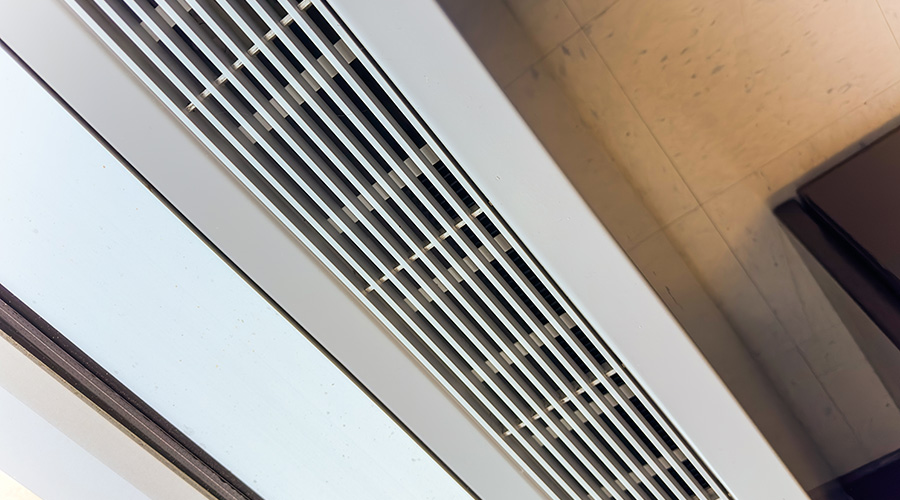Schooled in IAQ
Managers in award-winning K-12 districts spotlight strategies that cleared the air in their facilities
By Renee L. Shroades, Associate Editor
The frustration that surrounds the issue of poor indoor air quality (IAQ) often centers on this fact: The problem is invisible.
Maintenance and engineering managers who handle IAQ complaints often must work with nebulous symptoms — funny smells, watery eyes, headaches, etc. — in their search for a cause and, hopefully, a remedy.
There is good news, though. A growing number of managers are having success diagnosing IAQ problems and implementing remedies that are clearing the indoor air. Many such success stories are occurring in the nation’s K-12 school districts, where researchers are discovering closer links between healthy indoor air and improved student performance.
Blue Valley Unified School District in Overland Park, Kan., is one such organization. In 2005, it earned the Sustained Excellence Award from the U.S. Environmental Protection Agency (EPA), the agency’s most prestigious IAQ award.
“We want to create outstanding learning environments for kids by improving IAQ,” says Dave Hill, the district’s executive director of facilities and operations. Because his district wants to make IAQ a top priority, the school’s administration made that goal part of its overall strategic plan.
Around the country, managers are more successfully identifying the causes of IAQ problems in their buildings and developing cost-effective solutions. Now, managers in award-winning districts are sharing the lessons they’ve learned.
The Heart of IAQ
Because HVAC systems play such a central role in IAQ, they often are the first place managers can turn when looking for ways to improve IAQ.
Blue Valley School District has incorporated underfloor air-distribution systems in the design of its new schools and retrofitted a school with displacement-air technology to achieve better airflow. Underfloor air distribution has the potential to improve thermal comfort, ventilation efficiency and IAQ.
A member of Hill’s department served as project manager for the renovation, which involved installing surface-mounted tubes throughout the building, which introduce fresh air at the floor level.
“When you’re introducing displacement-air technology into an existing building, you obviously don’t have the opportunity to raise the floor and distribute the air using the underfloor-distribution method,” Hill says. To achieve the same affect, technicians installed tubes in corners or other non-intrusive areas.
“In a typical 750-square-foot classroom, one tube is usually enough to bring in an adequate amount of fresh air into that space,” Hill says, adding that the technology has helped minimize IAQ-related complaints and student absenteeism.
“We've seen dramatic improvements in the air quality in that building,” Hill says. “The complaints related to air quality from staff and students have dropped off to virtually nothing.”
Also contributing to the improvements are carbon dioxide (CO2) sensors that monitor the amount of fresh air circulated into every room. Occupied rooms have higher levels of CO2 than unoccupied rooms, Hill says. If the sensors report a CO2 level common to classrooms occupied by 25 students and a teacher, the system will send a maximum amount of fresh air to that area. When occupancy drops, the level of CO2 decreases, and the system decreases the amount of fresh air to that space.
“Those CO2 sensors really work well when a classroom is scheduled for only six of eight periods of a day,” Hill says. “By using that technology, not only have we increased indoor air quality, but we also reduced energy consumption in that building by 20-30 percent annually.”
Not surprisingly, areas in which air particulates are most abundant, such as shop classrooms where students work on wood and metal projects, tend to receive more attention during IAQ troubleshooting.
“Woodshop areas have a potential for a high amount of dust particulates in the air, and if you don't handle the wood waste correctly, mold can grow in it,” Hill says. “We used to have an outdated system that actually exhausted the air in such a way that it caused moisture to collect in the bag where the sawdust particles were being exhausted.” The mixture of sawdust and moisture allowed mold the opportunity to grow.
“We replaced the system in favor for one that doesn’t have a place where dust particles can come in contact with moisture condensation,” he says.
Humidity Issues
Indoor spaces that contain water and increased levels of humidity — locker rooms and swimming pools, for example — also come under closer scrutiny from technicians trying to pinpoint IAQ problems.
“HVAC systems for pools are very tricky,” Hill says. Chemicals used to treat pool water trigger the release of airborne chloramines, which are volatile organic compounds (VOC). Chloramines can lead to nausea, headaches and vomiting. To minimize chloramines, HVAC systems need to direct more fresh air to these areas than to other spaces that are similar in size, such as gymnasiums.
“But it’s not just enough to pump fresh air into the space,” he says. “It has to move through the space the right way, and it has to be extracted from the space the right way.”
Because the highest concentration of chloramines is in the 6 inches above the water’s surface, HVAC systems should push fresh air as close to the pool’s surface as possible, Hill says. Systems regulating the air for the district’s older pool areas were not originally designed to push fresh air most effectively.
“So we added blower fans just a few feet off the pool deck to move that air,” he says. “We also changed out the rooftop mechanical systems that introduced the fresh air with ones that move air more quickly and allow more air exchanges per hour.”
To further reduce the chloramines, Hill advises managers to minimize swimmers’ access to the pool to avoid overuse and chemical imbalances, and to require swimmers to take showers before entering the pool to prevent body lotion and hairspray from getting in the water, which can increase the risk for IAQ problems.
Helpful Tools
Managers have an array of instruments to choose from to measure the components of IAQ, such as CO2, carbon monoxide (CO), humidity, and VOCs.
Elaborate monitoring devices are not always necessary to ensure healthy IAQ, says Jim Fite, safety assistant to the director of plant facilities at Cecil County Public School District in Elkton, Md. It is more important for technicians to regularly monitor IAQ in all spaces. The district earned the EPA’s 2005 Excellence Award for its IAQ efforts.
“We try to make the process as simple as possible,” he says. His department uses relatively simple instruments, such as handheld devices, to monitor CO, CO2, temperature and humidity.
Peggy Caruso, assistant director of maintenance and operations, environmental at Katy (Texas) Independent School District, says that while her department uses a variety of IAQ testing equipment, one of the best tools is a simple moisture meter. The device lets technicians know if moisture levels in materials, such as drywall, are higher than normal. The meters are particularly useful in areas where technicians suspect water intrusion.
“If we suspect water intrusion or see mold at the baseboard, we'll drill a 3-inch hole in the wall and use a moisture meter to help find the cause of the damage,” she says.
Infrared thermography has become a more popular and useful technology in recent years for detecting a range of problems in facilities, including water problems.
“The cameras have helped us with our building-envelope program and prevent moisture intrusion into buildings,” Hill says. “The key is to attack a water-intrusion problem before it becomes a mold problem.”
Caruso also praises infrared thermography for its ability to detect roof leaks, although her district doesn’t own infrared equipment capable of inspecting large areas.
“If we need to inspect a huge roof, we hire a third party because we don't have the equipment to do it ourselves,” she says.
One potentially valuable resource for managers is HealthySEAT, software the EPA developed to assist with IAQ improvement efforts. School districts can customize the free software to assess potential problems, such as mold, asbestos and lead paint. It helps users track and manage information on environmental conditions in facilities, giving them an opportunity to pinpoint areas for IAQ improvement.
Vashon Island (Wash.) School District plans to install the software and begin using it this year, says Janine Ducharme, the district’s facilities director. After solving several IAQ problems caused by water intrusion and mold, her district won the EPA’s 2005 Excellence Award for its IAQ measures.
Tools alone, however, will not lead to a successful IAQ program. It also requires support from school administrators, teachers and staff.
Raising awareness of the importance of good IAQ practices will help maintenance and engineering managers build support for their departments’ efforts.
Managers and technicians also should respond to IAQ concerns quickly.
Says Hill, building occupants need to “know that if they sense an IAQ problem, they can call us and know that they will get a response.”
‘Small’ Steps, Big Payoffs
Indoor air quality (IAQ) often is a big issue. But managers can help their organizations make seemingly minor changes that lead to improved IAQ. These measures include making sure objects are not blocking air returns and supplies, or asking teachers to regularly clean areas they are responsible for, such as cabinets in science labs.
“Little things like that can really impact everybody,” says Peggy Caruso, assistant director of maintenance and operations, environmental, at Katy (Texas) Independent School District.
Managers also might consider these suggestions from managers in districts that have been recognized by the U.S. Environmental Protection Agency for their IAQ-improvement efforts:
Implement an integrated pest-management (IPM) program. Pests can cause illnesses and allergies, and an IPM program can help prevent these problems.
“We’ve added new door sweeps to hundreds of doors throughout the district to prevent pests from entering the buildings,” says Dave Hill, executive director of facilities and operations at Blue Valley School District in Overland, Kan.
Pests can be a particular concern for managers of buildings in rural areas. Instead of using poisons, workers at the Cecil County Public School District in Elkton, Md., prevent pest problems with other measures, such as using traps and plugging access to areas animals might like to nest, says Jim Fite, safety assistant to the district’s director of plant facilities.
Specify equipment that improve IAQ. Hill specifies carpet extractors with a light-extraction mode, which uses less water and reduces mold growth in carpets. Specifying floor machines that feature dust-control devices can help reduce dust particulates.
Inform occupants of practices that harm IAQ. Sometimes, occupants don’t realize their actions can contribute to IAQ problems. For example, Hill says students’ paper-mache projects triggered an art teacher’s allergic reaction.
“Our IAQ monitors showed that there was a higher-than-normal mold-spore count of a particular type of mold spore in her teaching area,” Hill says. “The lab results said that this type of mold likes to grow on paper products. It turned out that just a couple of days before she showed allergy symptoms, she assigned her students to make paper-mache projects, which were drying in the room. She no longer uses paper mache as a three-dimensional art project, and her allergy symptoms have stopped.”
Participate in the EPA’s Tools for Schools program. By reviewing checklists in the Tools for Schools kit, managers can get a new perspective of their building systems and operations.
“The kit gave us a place to start and helped us focus on what to look for to prevent and deal with IAQ problems,” says Janine Ducharme, facilities director for Vashon Island School District in Vashon, Wash. For example, the program helped Ducharme and her department discover leaks in the buildings’ envelope and identify other potential problems, such as plugged roof drains.
For more information on the program, visit http://www.epa.gov/iaq/schools/toolkit.html
— Renee L. Shroades
|
The Role of UVC in IAQ
Growing concerns about indoor air quality has led researchers and manufacturers to focus on potential remedies that incorporate ultraviolet radiation-C (UVC) technology. Evidence indicates that high-output UVC lights in air-handling systems can destroy the DNA of microbes.
In addition to preventing mold growth in HVAC systems, proponents believe the technology can hinder the spread of harmful airborne contaminants, including:
-
strains of influenza
-
viruses, such as colds, SARS, and measles
-
bacteria, such as tuberculosis and Legionella.
The California Energy Commission’s Public Interest Energy Research Program is taking a close look at potential benefits of UVC technology in schools. The organization is conducting research to determine if the presence of UVC lights in HVAC systems improves the health of building occupants in K-12 schools.
— Renee L. Shroades
|
Related Topics:












